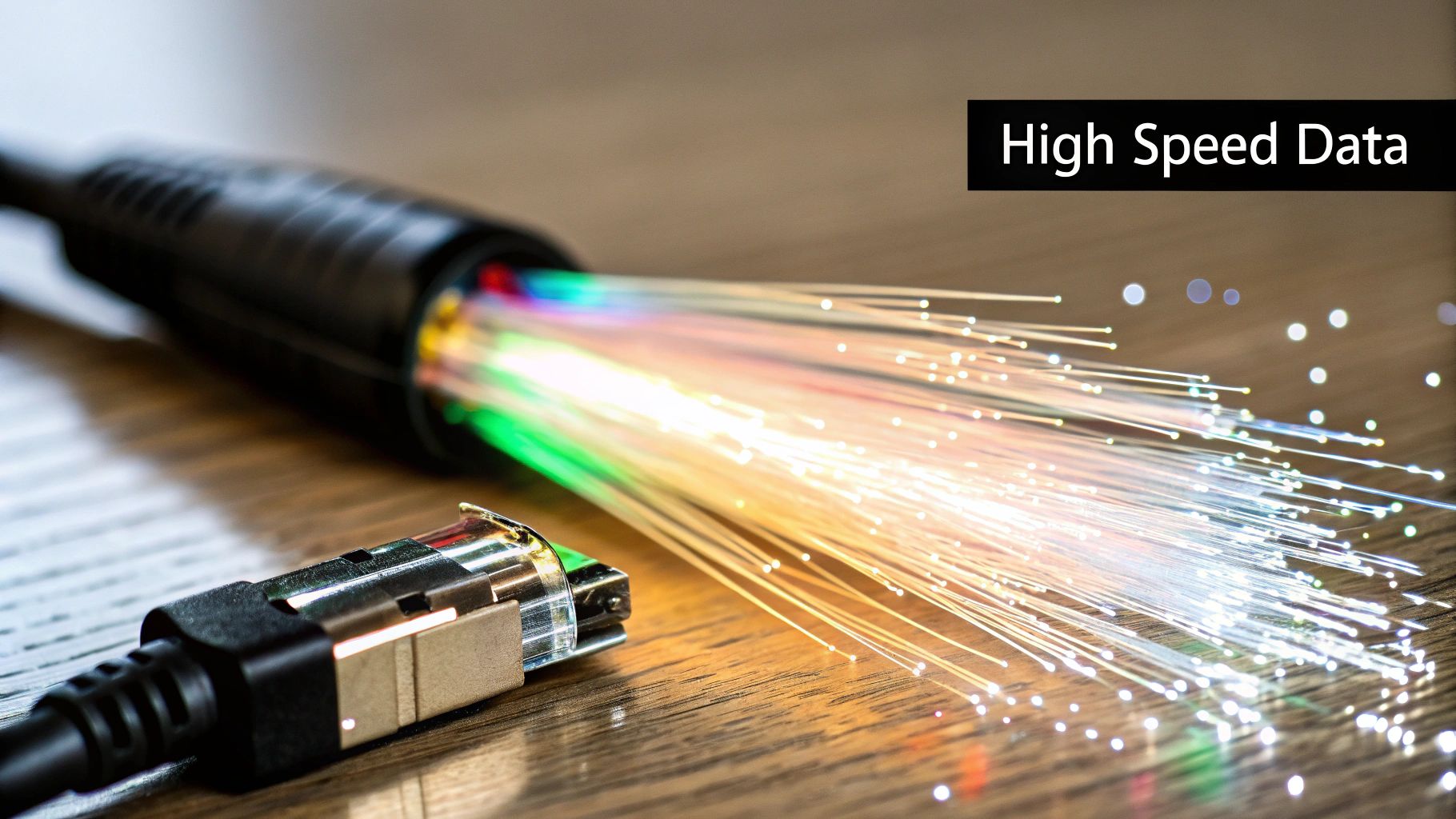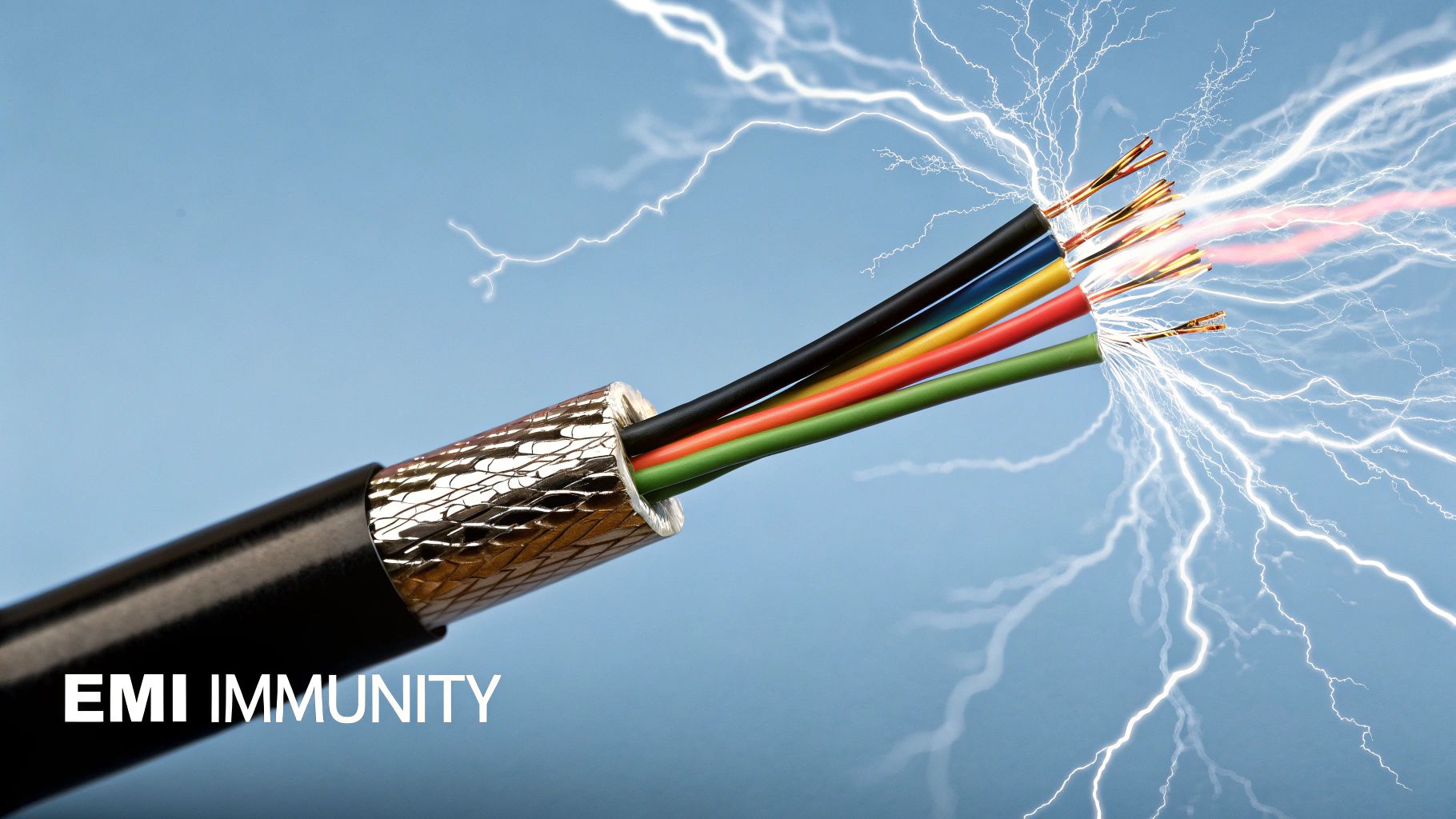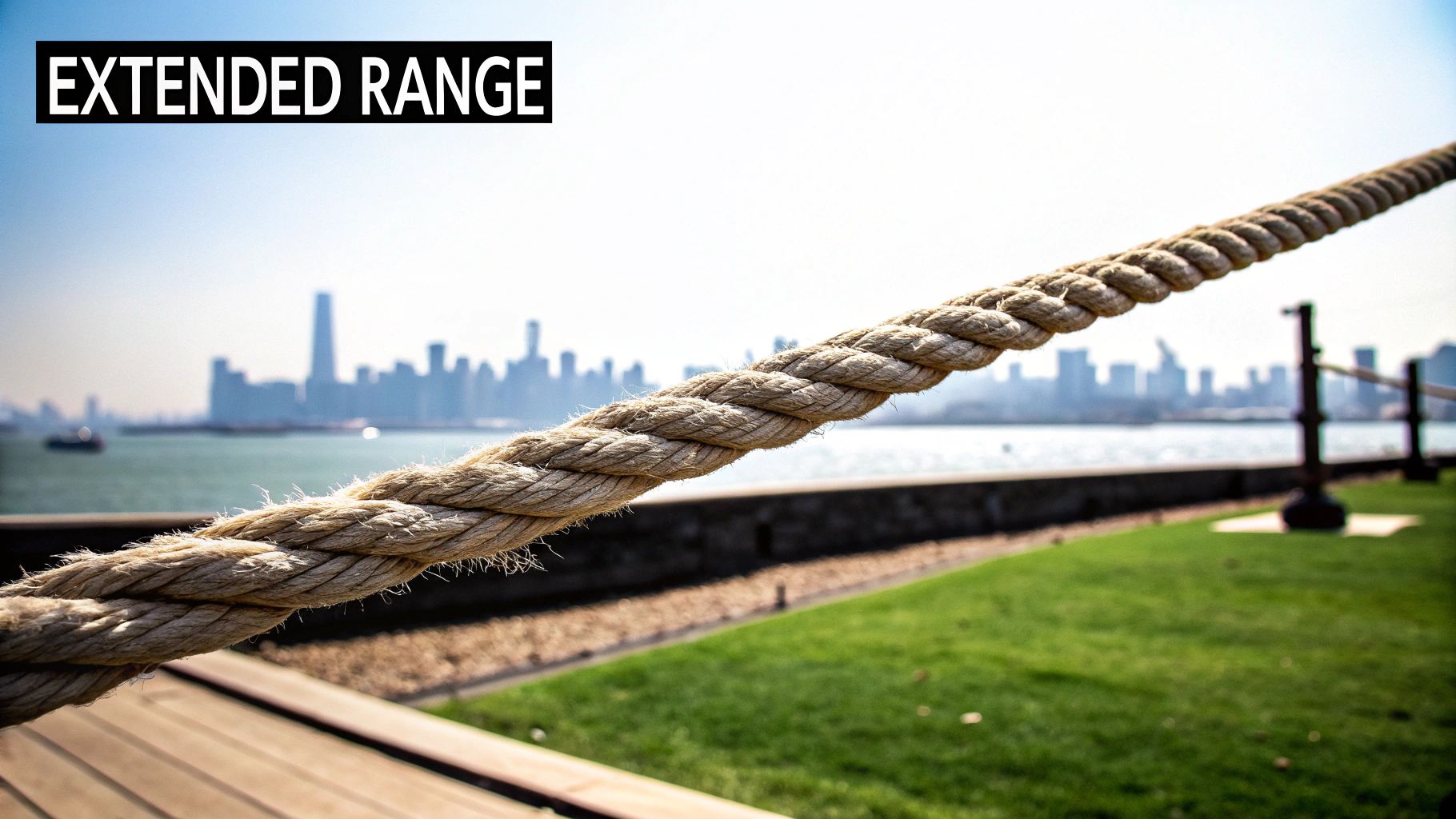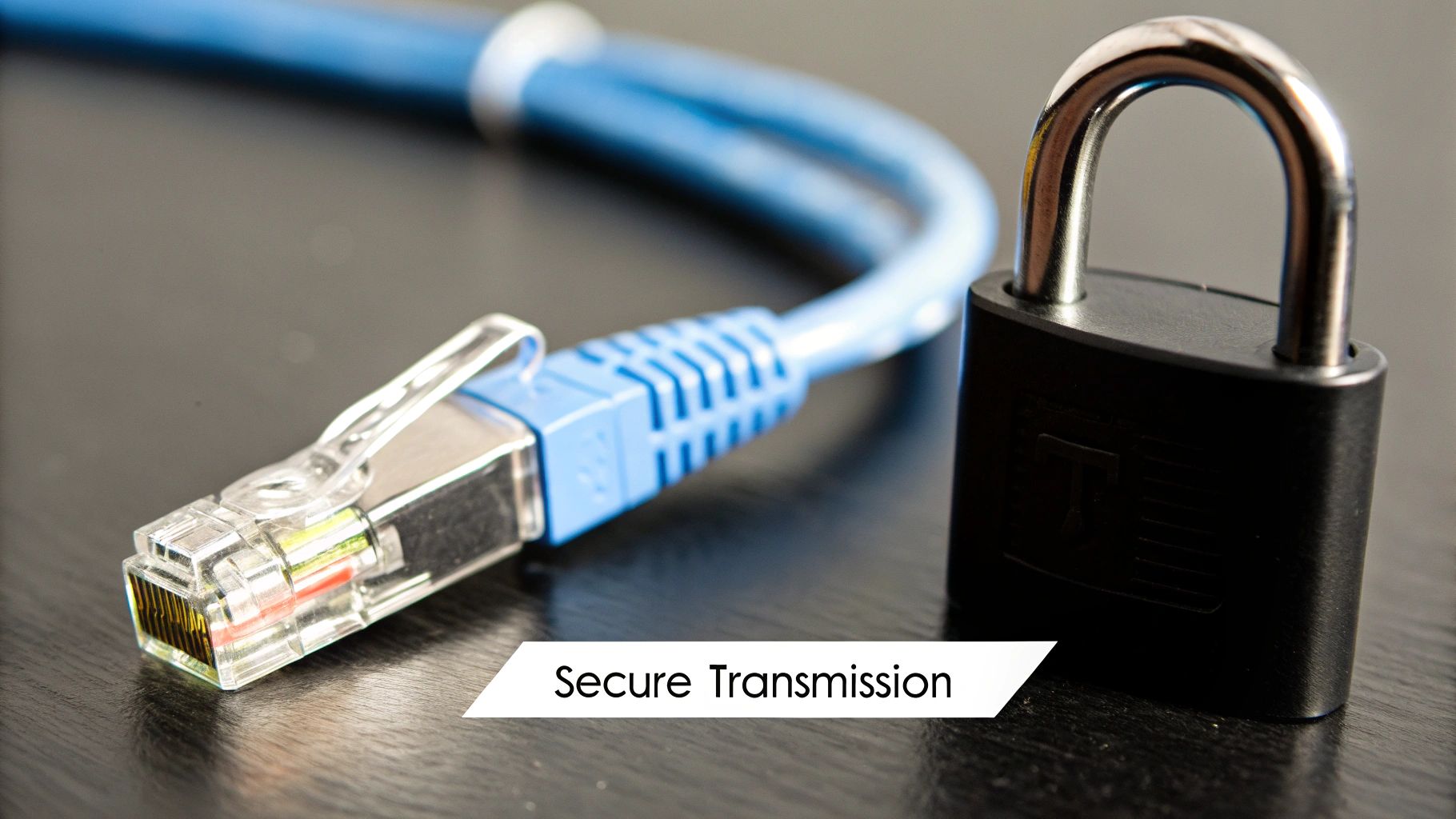In an era where digital operations are the backbone of every successful enterprise, from bustling hotels and sprawling multi-family complexes to state-of-the-art senior living facilities, the quality of your network infrastructure is non-negotiable. While Wi-Fi and cloud services often get the spotlight, the hidden foundation supporting it all is the cabling. For decades, copper was the standard, but its limitations are becoming increasingly apparent as data demands grow. Today, the conversation has shifted to a far superior alternative.
Understanding the core fiber optic cable benefits is crucial for any business leader looking to future-proof their operations, enhance user satisfaction, and secure a competitive edge. This guide moves beyond mere speed to explore eight transformative advantages of adopting fiber. We will uncover how this technology delivers unparalleled reliability, security, scalability, and long-term value.
You will gain actionable insights and see real-world examples tailored for commercial, hospitality, and residential properties. We’ll examine how fiber supports everything from high-density Wi-Fi in a hotel to critical life-safety systems in a senior living community. This article will demonstrate precisely why a strategic investment in fiber is one of the smartest infrastructure decisions you can make for your property’s future.
1. High-Speed Data Transmission
One of the most significant fiber optic cable benefits is the unparalleled speed at which it transmits data. Unlike traditional copper cables that use electrical signals, fiber optic technology uses light pulses sent through infinitesimally thin strands of glass or plastic. This method allows data to travel at speeds approaching the speed of light, delivering bandwidth capabilities that start at 1 Gigabit per second (Gbps) and can scale to 100 Gbps and beyond.

This incredible speed fundamentally transforms digital experiences. For a hotel, it means guests can simultaneously stream 4K movies, participate in video conferences, and use cloud applications without lag. In a multi-family residential building, it becomes a powerful amenity, attracting and retaining tenants who rely on fast, stable internet for remote work, online education, and entertainment.
Real-World Speed in Action
The impact of fiber’s high-speed transmission is evident across various sectors. For instance, hospitals depend on fiber to transfer massive medical imaging files, like MRIs and CT scans, between departments in seconds, accelerating diagnosis and patient care. Similarly, financial institutions leverage fiber’s near-instantaneous data transfer for high-frequency trading, where even a microsecond delay can result in significant financial loss. This level of performance is simply unattainable with older cable technologies.
How to Implement and Maximize Speed
To harness fiber’s full potential, a strategic approach to implementation is crucial. It’s not just about installing the cable; it’s about building a coherent, high-performance network ecosystem.
- Choose the Right Fiber Type: For applications requiring the highest speeds over long distances, such as connecting buildings across a large commercial campus or a senior living community, single-mode fiber is the superior choice.
- Match Your Equipment: Ensure that your network switches, routers, and other hardware are rated to handle the bandwidth your fiber optic cabling provides. A 10 Gbps fiber link is useless if connected to a 1 Gbps switch.
- Monitor Your Network: To fully leverage high-speed capabilities and ensure consistent performance, it is essential to use effective network performance monitoring tools. These systems help identify bottlenecks and verify that you are getting the speeds you pay for.
2. Immunity to Electromagnetic Interference
Another one of the critical fiber optic cable benefits is its complete immunity to electromagnetic interference (EMI) and radio frequency interference (RFI). Because fiber optic cables transmit data using pulses of light through glass strands, they are entirely unaffected by the electrical “noise” generated by nearby power lines, heavy machinery, or other electronic devices. This is a stark contrast to traditional copper cables, where electrical signals can be easily corrupted, leading to data errors and network instability.

This immunity makes fiber the superior choice for environments where data integrity is non-negotiable. In a hospital setting, for example, fiber optic cables can run alongside powerful MRI machines and other critical medical equipment without any signal degradation. For a manufacturing plant or industrial facility, this ensures that control systems and data monitoring networks operate flawlessly, even amidst the electromagnetic chaos of motors, generators, and welding equipment.
Real-World Reliability in Action
The practical impact of EMI immunity is profound. Military and aerospace applications rely on fiber’s resilience to ensure secure, jam-proof communications in challenging operational environments. Data centers, which are dense with servers and power distribution units creating a high-EMI landscape, use fiber as a standard to guarantee reliable connections between servers and network equipment. This inherent robustness ensures clean, error-free data transmission, regardless of the surrounding electrical activity.
How to Implement and Maximize Interference Immunity
Deploying fiber to leverage its EMI resistance requires planning for the specific environmental challenges your facility faces. This ensures your network remains stable and reliable where copper would fail.
- Install with Confidence: Place fiber optic cables directly alongside high-voltage power lines or industrial machinery without the need for expensive and bulky shielding that copper would require.
- Ideal for Outdoor and Lightning-Prone Areas: Since fiber optic cables are dielectric (non-conductive), they are immune to lightning-induced power surges that can destroy copper-based networks. This makes fiber the safest choice for outdoor or campus-wide installations.
- Ensure Clean Data in Medical Facilities: Prioritize fiber for network backbones in hospitals and clinics, especially in wings with diagnostic imaging or life-support equipment, to protect critical patient data and system communications.
3. Extended Transmission Distance
One of the most transformative fiber optic cable benefits is the ability to transmit data over vast distances without losing signal integrity. Unlike copper cables, which suffer from signal degradation and are typically limited to 100 meters for high-speed networks, fiber optic technology uses light pulses that can travel for many kilometers with minimal attenuation. This capability fundamentally reduces infrastructure complexity and cost for large-scale network deployments.

For a sprawling university campus or a large-scale senior living community with multiple buildings, this means connecting every facility to a central network without needing expensive signal boosters every few hundred feet. Similarly, a hotel resort spread across a large property can ensure consistent, high-quality connectivity from the main lobby to the most remote guest villas, all on a single, unified network.
Real-World Distance in Action
The superiority of fiber over long distances is proven in the most demanding environments. Telecommunication giants use single-mode fiber to create metropolitan area networks connecting entire city districts. It’s also the technology behind submarine cables that span oceans, delivering global internet connectivity. On a more local scale, airports use fiber to link terminals, air traffic control towers, and remote facilities kilometers apart, ensuring seamless operations and security. This long-reach capability is essential for modern infrastructure.
How to Implement and Maximize Distance
Deploying fiber for long-distance connectivity requires careful planning to maintain signal strength and reliability. The goal is to design a robust physical link that minimizes points of failure and signal loss.
- Select the Right Cable: For any connection extending beyond 550 meters, single-mode fiber is the industry standard. Its smaller core is designed specifically for long-haul signal transmission with minimal dispersion.
- Plan Your Route Carefully: Map out the fiber path to minimize sharp bends and stress points, which can cause micro-fractures and increase signal loss. A well-planned route is crucial for maximizing distance and lifespan.
- Minimize Signal Loss: Use fusion splicing instead of mechanical connectors for permanent links. Fusion splicing creates a nearly seamless connection between two fiber strands, resulting in significantly lower signal loss and ensuring the signal can travel its maximum potential distance.
4. Enhanced Security and Privacy
Beyond speed and reliability, one of the most critical fiber optic cable benefits is its inherent security. Traditional copper cables are susceptible to “tapping,” where data can be intercepted by detecting the electromagnetic signals they emit. Fiber optic cables, which transmit data as pulses of light through a glass core, do not produce these emissions, making them nearly impossible to intercept without physically accessing the fiber itself.

This physical security is a game-changer for any organization handling sensitive information. Any attempt to physically tap a fiber optic cable requires bending the fiber to capture light, an action that creates a detectable disruption in the signal. This allows network administrators to be alerted immediately to a potential breach, a capability that copper cabling simply cannot offer.
Real-World Security in Action
This superior security model is why fiber is the standard for entities where data integrity is non-negotiable. Government and military agencies rely on fiber for secure communications, while financial institutions use it to protect high-value trading data from corporate espionage. In healthcare, fiber is essential for maintaining patient privacy under strict regulations. For a hotel or multi-family property, a secure fiber network protects guest and resident data from theft, safeguarding both privacy and the property’s reputation.
How to Implement and Maximize Security
Deploying fiber provides a strong security foundation, but maximizing its potential requires a few strategic steps. The goal is to create a multi-layered defense where the physical security of fiber complements digital security protocols.
- Implement Optical Monitoring: Use systems that continuously monitor the light levels in the fiber. This allows for immediate detection of any physical tampering or signal degradation that could indicate a security threat.
- Use Armored Cabling: In areas where the cable is accessible, such as utility closets or outdoor conduits, use armored fiber optic cables. These have a protective metal layer that resists crushing and cutting attempts.
- Combine with Encryption: While fiber is physically secure, data should still be encrypted. This ensures that even in the highly unlikely event of a successful tap, the intercepted data remains unreadable and useless to unauthorized parties. You can learn more about enhancing network security in healthcare, a sector with stringent data protection requirements.
5. Superior Bandwidth Capacity
Beyond raw speed, another of the core fiber optic cable benefits is its immense bandwidth capacity. While traditional copper cables are limited by their physical properties, fiber optic cables have a virtually unlimited capacity for data. This is achieved through a technology called wavelength division multiplexing (WDM), which allows multiple independent data streams to be transmitted simultaneously over a single strand of fiber, each using a different wavelength (color) of light.
This technology essentially turns one fiber cable into a multi-lane superhighway for data. For a large multi-family building or a bustling hotel, this means that as demand grows for bandwidth-intensive applications like 8K streaming, virtual reality (VR) experiences, and a building-wide network of IoT devices, the existing fiber infrastructure can scale to meet the demand without the need to install new, disruptive cabling.
Real-World Capacity in Action
The power of fiber’s bandwidth is most evident in environments that manage massive, concurrent data flows. Major cloud providers like Amazon AWS and Microsoft Azure rely on WDM over fiber to handle the immense traffic between their data centers. Similarly, internet service providers use it to deliver distinct, high-speed connections to thousands of residential and commercial customers over a shared backbone infrastructure. This makes fiber the only viable choice for future-proofing a property against exponential data growth.
How to Implement and Maximize Bandwidth
To fully leverage fiber’s capacity, your network must be designed with scalability in mind from the outset. Strategic planning ensures you can expand your network’s capabilities as future technologies become mainstream.
- Plan for WDM from the Start: Even if not needed immediately, designing the network infrastructure to accommodate WDM equipment later saves significant future costs and complexity. Proper network capacity planning is crucial.
- Invest in High-Quality Fiber: To support a wide range of light wavelengths without signal degradation, using high-quality single-mode fiber is essential. This ensures your cabling can handle future multiplexing technologies.
- Use Appropriate Multiplexing Equipment: Select multiplexers and demultiplexers (mux/demux) that match your current and projected bandwidth needs. This hardware is what combines and separates the different light signals.
- Design for Future Growth: Allocate space and power in your network closets for future equipment upgrades. This foresight allows you to seamlessly add capacity as demand on your property increases.
6. Environmental Durability and Longevity
Another of the key fiber optic cable benefits is its exceptional resilience against harsh environmental factors. Unlike copper cabling, which is susceptible to corrosion, moisture damage, and temperature fluctuations, fiber optic cables are made of glass or plastic, making them inherently more durable. This construction grants them superior resistance to temperature extremes, corrosive chemicals, and UV radiation, ensuring long-term operational integrity.
This remarkable durability means a fiber network, when properly installed, can function reliably for 25 to 30 years or even longer. For a commercial property or senior living community, this translates into a stable, long-lasting infrastructure asset that minimizes the need for costly repairs, replacements, and network downtime. It’s a true “install and forget” solution compared to the constant maintenance often required by legacy copper systems.
Real-World Durability in Action
The robust nature of fiber is proven in some of the world’s most demanding environments. Submarine cables laid across ocean floors operate for over 25 years despite immense pressure and saltwater corrosion. Likewise, industrial chemical plants rely on fiber to maintain data connectivity in highly corrosive atmospheres that would destroy copper wiring in short order. From desert installations withstanding extreme heat to Arctic research stations enduring freezing temperatures, fiber provides consistent performance.
How to Implement and Maximize Longevity
To ensure your fiber optic network achieves its maximum lifespan, a thoughtful installation strategy is essential. It’s not just about the cable itself but also about protecting it from environmental and physical threats.
- Choose Appropriate Cable Jackets: Select cables with jacketing material specifically designed for the deployment environment, whether it’s direct burial, aerial, or inside a conduit.
- Use Armored Cables: In areas with a high risk of physical damage from rodents or construction activities, using armored fiber optic cables provides an essential layer of protection.
- Select UV-Resistant Options: For outdoor aerial installations exposed to direct sunlight, always choose cables with a UV-resistant outer jacket to prevent degradation over time.
- Ensure Proper Installation Practices: Following manufacturer specifications for bending radius and pulling tension is critical to avoid damaging the delicate glass core during installation. Furthermore, their environmental durability means fiber optic cables can withstand harsh conditions, making them ideal for long-term outdoor and underground installations. For more practical insights into such infrastructure projects, you might refer to general guidelines for burying cables and pipes.
7. Lower Long-Term Operating Costs
While fiber optic cabling can have a higher initial installation cost, one of its most compelling long-term benefits is the significant reduction in operational expenses. Unlike copper networks that are energy-intensive and require frequent upkeep, fiber optic systems are designed for efficiency and longevity. This technology uses light instead of electricity, drastically cutting power consumption and eliminating the need for extensive cooling systems, particularly in data-heavy environments.
This efficiency translates directly into savings. For a large enterprise or a data center, the reduction in electricity and cooling costs can amount to thousands of dollars annually. In a multi-family property or hotel, lower energy usage and minimal maintenance needs reduce the overall cost of providing premium internet services, allowing property owners to offer a high-value amenity without the high operational overhead associated with older infrastructure.
Real-World Savings in Action
The financial advantages of fiber’s lower operating costs are proven across many industries. Telecommunications giants like Verizon and AT&T have invested billions in fiber infrastructure, citing massive savings in power and maintenance as a key driver. Similarly, large-scale data centers for companies like Amazon and Walmart have embraced fiber to reduce cooling expenses by up to 40%, a critical factor in maintaining profitability. In municipal networks, fiber optic cables installed decades ago continue to operate with minimal service, demonstrating their exceptional durability and long-term value.
How to Implement and Maximize Savings
To fully realize the cost-saving potential of fiber, a focus on long-term value over short-term expense is key. This requires careful planning and a strategic approach to both installation and management.
- Calculate Total Cost of Ownership (TCO): When evaluating the investment, look beyond the initial price tag. Project the TCO over a 10-to-15-year period, factoring in projected savings from lower energy bills, reduced maintenance calls, and less frequent equipment replacement.
- Invest in Quality Installation: The quality of the initial installation directly impacts future maintenance costs. Partnering with experienced professionals is crucial. For more details, see these guidelines for finding qualified structured cabling installers.
- Document Your Network: Create and maintain thorough documentation of your network layout, including cable paths and connection points. This simple step can dramatically reduce troubleshooting time and costs if an issue ever arises.
8. Lightweight and Space-Efficient Design
A less-discussed but highly practical fiber optic cable benefit is its incredibly lightweight and compact design. Compared to traditional copper cables with similar information-carrying capacity, fiber optic cables are dramatically thinner and can weigh up to 80% less. This is because they use thin glass strands instead of bulky copper wires, making them far easier to handle, install, and fit into tight spaces.
This weight and space efficiency is a game-changer in environments with physical constraints. For a high-rise hotel or multi-family building, it means more cables can be routed through existing, crowded conduits without requiring costly structural modifications. In a data center, the smaller diameter allows for better airflow and cooling, reducing operational costs while increasing density.
Real-World Efficiency in Action
The advantages of fiber’s compact design are critical in specialized industries. Aerospace manufacturers like Boeing and Airbus use fiber optics to reduce aircraft weight, which translates directly to fuel savings and increased payload capacity. Similarly, on ships and offshore platforms where every square inch is valuable, fiber provides high-speed connectivity without sacrificing precious space. Telecommunications companies also benefit by reducing the structural load on mobile communication towers.
How to Implement and Maximize Space Efficiency
To leverage fiber’s space-saving design, proper planning and installation are essential. It’s about more than just choosing a smaller cable; it’s about optimizing the entire infrastructure.
- Plan Your Pathways: Carefully map out cable routes in advance, especially in retrofits of older buildings like historic hotels or senior living facilities. This ensures you can navigate tight corners and conduits without violating the fiber’s minimum bend radius, which could damage the cable.
- Use High-Density Solutions: For environments like data closets or server rooms, opt for high-density fiber patch panels and connectors. Manufacturers like Panduit and CommScope offer solutions that maximize connection points in a minimal amount of rack space.
- Leverage Proper Management: Invest in appropriate cable management systems, such as trays and vertical managers. These systems protect the delicate fiber cables from stress and tangles, ensuring long-term reliability and making future maintenance much simpler.
8 Key Benefits Comparison
| Feature / Aspect | High-Speed Data Transmission | Immunity to Electromagnetic Interference | Extended Transmission Distance | Enhanced Security and Privacy | Superior Bandwidth Capacity | Environmental Durability and Longevity | Lower Long-Term Operating Costs | Lightweight and Space-Efficient Design |
|---|---|---|---|---|---|---|---|---|
| Implementation Complexity 🔄 | Requires specialized equipment and expertise | Different installation techniques needed | Complex splicing and termination procedures | Specialized security monitoring equipment needed | Advanced multiplexing equipment required | Careful handling and installation required | Specialized installation and repair expertise | Requires careful handling and unique tools |
| Resource Requirements ⚡ | High initial installation cost; specialized gear | Higher cost than copper; unique installation tools | Higher upfront cable and equipment cost | Higher installation costs; security monitoring | Higher initial investment in WDM technology | Higher upfront material costs | Higher capital expenditure initially | Lower shipping cost; need proper cable supports |
| Expected Outcomes 📊 | Near light-speed transmission, scalable bandwidth | Stable signal unaffected by EMI/RFI | Long-distance transmission up to 100 km+ without loss | Detectable intrusion; no EM emissions | Massive data capacity with WDM | Reliable 25-30+ year operation in harsh conditions | Significant long-term operational savings | 80% lighter and smaller; fits tight spaces |
| Ideal Use Cases 💡 | 4K/8K streaming, real-time data, trading | Industrial plants, hospitals, radio & military sites | Campus, metro, submarine cables, rural ISPs | Government, financial, healthcare, critical infra | Data centers, ISPs, broadcast, research, smart cities | Underwater, chemical plants, deserts, extreme temps | Enterprise data centers, telecom, municipal networks | Aerospace, ships, high-rise buildings, dense data centers |
| Key Advantages ⭐ | Extremely fast; future-proof scalability | Immunity to interference; consistent signal quality | Fewer repeaters; simplified network design | Immediate breach detection; high tap resistance | Future-proof scalable bandwidth; reduces clutter | Durable under extreme environmental conditions | Lower power use and maintenance costs; longevity | Lightweight; space-efficient; easier installation |
The Strategic Imperative of Fiber: Your Next Steps
The evidence presented throughout this article is clear and compelling. The conversation around fiber optic cable benefits has decisively shifted from a simple discussion of speed to a strategic analysis of operational capacity, long-term financial health, and competitive advantage. Moving beyond legacy copper wiring is no longer a luxury upgrade; it is a fundamental requirement for properties aiming to meet the modern demands of tenants, guests, and employees.
We’ve explored how fiber’s immunity to electromagnetic interference ensures stable connections in electrically noisy environments, a critical factor for hospitality venues and commercial buildings. We’ve seen how its extended transmission distance without signal degradation simplifies network design for large multi-family complexes and sprawling senior living campuses. The inherent difficulty in tapping fiber optic lines provides a level of enhanced security that is simply unattainable with traditional cabling, protecting sensitive data and user privacy.
Synthesizing the Core Advantages
The true power of fiber emerges when you view these advantages not in isolation, but as an interconnected ecosystem of value.
- Future-Proofing Your Asset: The superior bandwidth capacity of fiber isn’t just for today’s needs. It prepares your property for the technologies of tomorrow, from 8K streaming and augmented reality amenities to the proliferation of Internet of Things (IoT) devices. This scalability ensures you won’t need another costly infrastructure overhaul in just a few years.
- Driving Financial Efficiency: While the initial installation cost is a consideration, the long-term ROI is undeniable. Fiber’s environmental durability, minimal maintenance needs, and lower energy consumption translate into significantly lower long-term operating costs. This is a direct and positive impact on your net operating income.
- Enhancing User Experience: Ultimately, the technology serves people. For a hotel guest, it means flawless Wi-Fi. For a multi-family resident, it means seamless remote work and entertainment. For a senior living resident, it means reliable access to telehealth services. A robust fiber network is the backbone of a premium experience that attracts and retains high-value tenants and customers.
Your Actionable Path Forward
Understanding the fiber optic cable benefits is the first step. The next is to create a strategic implementation plan. Begin by conducting a thorough audit of your current network infrastructure. Identify bottlenecks, assess future bandwidth requirements based on your specific property type, and calculate the potential ROI of an upgrade. Consider a phased approach if necessary, prioritizing high-demand areas first.
The most crucial step is engaging with an expert partner who can navigate the complexities of network design, installation, and management. This ensures your investment is optimized from day one, delivering the reliability and performance your stakeholders expect. The decision to invest in a fiber optic backbone is a decision to invest in the future relevance, security, and profitability of your property. It is the definitive infrastructure for the digital age.
Ready to unlock the full potential of fiber for your property without the upfront capital expenditure? Clouddle Inc specializes in designing, deploying, and managing high-performance networks for the hospitality, MDU, and commercial sectors. Discover how our Network-as-a-Service model can provide a future-proof fiber network with zero down payment by visiting Clouddle Inc today.


